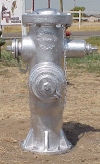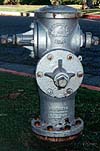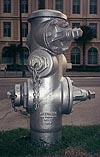Join our Email List | Collectors Club | Hydrant Links | We Need Your Help | Contact Us
|
|
Join our Email List | Collectors Club | Hydrant Links | We Need Your Help | Contact Us |
|
We would be delighted to try and obtain an answer to any questions you might have regarding fire hydrants, whether of a technical or general nature. Below are recent questions and answers from the FireHydrant.org mailbag. If you have a question, Email Us. |
|
#13 - Hello: I am trying to find out what the standard distance between fire hydrants in a commercial area with some residential (apartment building and trailer park). I would like to know what is the reference for the regulation that describes the distance. There are several standards which may or may not be adopted in your particular state. The Uniform Fire Code places the final authority with the "Chief of the Department" (Fire Chief.) A good rule of thumb which is fully recognized by the Insurance Services Office (the agency that rates and assigns risks to communities and fire departments) is: Spacing not to exceed 500 ft between hydrants Hydrants to be within 250 ft of any building protected Total fire flow volume to be within 1000 Ft (note 1). (for example, if a building calculates out to require a fire flow of 3500 GPM, that volume has to be available from the aggregate of hydrants within 1000 Ft. (note 1), flowing simultaneously. Note 1: The 1000 ft standard applies ONLY if every engine in the fire department, excepting reserve apparatus, carries 1000 ft. of large diameter hose. Otherwise hydrants greater than 500 ft away receive only partial credit. Also how much would a Class A (1000-1400 gpm) fire hydrant cost? That depends on a variety of factors. A good quality fire hydrant is less than $1,000. We budget a complete installation (tee, street valve, lateral, bury, extension and hydrant body, properly bedded trench, contractor's labor) at $3,500 during construction when there is no existing pavement to remove and replace and trenching equipment is already in place, and at $6,500 when streets, sidewalks, etc. have to be opened up and then replaced. Variants also include lateral distance from the main to where the hydrant is actually sited and conflicts with other buried utilities. The most costly component is the feed main. For example, a Model 64 hydrant body (common in California) retails for about 850.00 and reliably delivers up to 3180 GPM. However most Model 64s don't deliver that volume because the capacity of the water mains is not sufficient. If your water main system is properly designed (to deliver the total required fire flows for the buildings protected) and you don't have extreme low head (low pressure) issues in your system, then virtually any 6" barrel hydrant that has a 4" or 4½" pumper outlet should produce not only a Class-A but most likely a Class-AA flow. If you have an average head of around 65 psi and the residual pressures in the mains stay relatively stable when hydrants are flowing, a standard 5¼" hydrant body attached to a 6" lateral and having a pumper outlet should also meet Class A criteria and in some cases will meet class AA. If your water main system cannot deliver larger flows, you can reduce the required fire flows by requiring approved sprinkler systems in the buildings being protected which in most instances reduces the fire flow requirement to below 1500 GPM. Hope this info helps. ":O) Willis Lamm,
|
|
#14 - I just stumbled across your site. VERY IMPRESSIVE!! But actually, I had a question. Do you know of any agency that has conducted a survey of municipal practices with regard to hydrant color? In our city hydrants have always been painted a fairly dark green, gnerally to make them unobtrusive we believe, although I can't find anyone who's been here long enough to verify the rationale. I would like to review our practice in this regard, primarily to achieve better visibility, but also perhaps to incorporate color coding for capacity, as is discussed in two of your referenced sites. I'd be interested if anyone has conducted a survey of hydrant color practices actually followed or adopted by different cities. Thanks. I'm not aware of any recent studies undertaken by fire agencies. The NFPA studied the issue some years ago and their conclusion was that chrome yellow was the most appropriate color for public fire hydrants. Part of that decision was based on practicality and commonality of usage. It's my personal belief that red is probably the most commonly used color with yellow close behind, but that's based on personal observation and estimating the number of hydrants that might be found in various municipalities. Chrome Yellow is the required color for hydrants in new jurisdictions that haven't previously adopted a standardized color. Chrome yellow is a bit shocking at first, however it does fade to a fairly mild looking, but still visible color. Volume color codes tend to stand out fairly clearly on yellow hydrants as well as any other indicators that one would want to apply. Another advantage of a light body color is that body damage, leaks, etc., can be more easily detected by passing fire companies or water works personnel. Dark hydrants seem to have problems that remain unnoticed until someone closely inspects them. 40 years ago when we didn't have so many vehicles on the street, so many cars competing for parking spaces, etc., so blocked hydrants didn't occur very often and hydrant visibility wasn't a significant issue. Fire agencies also had proportionately greater staffing so if a hydrant was blocked, there was sufficient personnel available to drag lines out to an alternative water source. Today the curb lines are jammed with cars and fire companies are often staffed at bare minimum levels. Accordingly it is more important than ever for hydrants to be noticed by motorists and be avoided when they park their cars. If it were my system, I'd paint the bodies yellow and cut out a cardboard stencil so it would be easy to paint the bonnets the appropriate color based on available fire flow. This will make the hydrants look ship-shape which should improve citizen confidence and put your community's best foot forward when ISO comes to grade you for the purpose of setting fire insurance rates. (Water supply makes up 40% of your community's total score.) Hope this limited info helps. ":O) Willis Lamm,
|
|
#15 - Hello, [I am] writing on behalf of Paramount Pictures. We are currently doing research for a film set in a Los Angeles suburb, in the year 1951. We are having some difficulty in finding accurate information on the style and color of the hydrants that would be found in this area during this period, and I would appreciate any information your organization might be willing to provide. Here are some images of old LA area hydrants: |
| This common model went into service in the early 1900s and many are still in service today: |
 |
A variation of this model was the "LA Sleeve" which had a unique bolt-up valve assembly. |
 |
 |
Since hydrants often last 100 years or more, any of these types of hydrants would be historically accurate for any period from pre WW-II through today. They all bolt down to a standard 6" 6-hole flange. I would check with the community that the picture will be set in and find out whether the hydrants were painted silver or yellow during that period. An old water works guy or the person in the fire department that handles hydrants should be able to tell you. Also, if you need loan of a hydrant or two for filming, I'm sure we can locate some suitable specimens from private collections. ":O) Willis Lamm,
|
|
#16 - Are there any standards for physical protection of fire hydrants (bollard type, size, spacing, etc.)? If a standard is not available, are there any common generally accepted practices? Thank you. The most common protection that I know of involves the use of 4" galvanized pipe. One 10 foot length can be cut in half, buried two feet with three feet remaining above ground. Fill the pipe with concrete, screw caps on the top and paint them a bright color (chrome silver, lime yellow or safety yellow) and you have a visible and formidable barrier. We set our bollards about 3' away from hydrant bodies. The specific locations vary depending on outlet orientation and approach of traffic. Hope this information helps. ":O) Willis Lamm,
|
|
#17 - Hi, I was looking up some information about fire hydrants and came across your web site. I am the facilities manager here and we are having an insurance inspector visit next week. He wants to test our hydrants, and the information on your site was very informative to me. I do have one question, the Codes and Regulations information, is that a state code or is it a national code? It says Uniform Fire Code. The Uniform Fire Code is a national code. Individual states may adopt it verbatim or they may amend code sections for application in their states. For all practical purposes most insurance inspections follow national codes and standards. Things I would consider in preparation for an inspection: 1 Make sure all hydrants are functional. Lubricate valves and caps. 2 Make sure all hydrants are clear and unobstructed. Maintain 3 ft clear space around every hydrant If you want to make things look really ship-shape, which can sometimes earn you the benefit of the doubt from the inspector if you run into any "gray zones," you can do the following: 1. Make sure your 5-year tests for required facilities (e.g., sprinkler systems) are current and readily accessible. (If you are behind, make an appointment for testing in the near future and have it documented so you can show the inspector that a test has been ordered.) 2. Make sure that facility maps and plans show ALL fire hydrants and other key fire service facilities. 3. Weather permitting, put a fresh coat of paint on the hydrants and make them look good. If your hydrants would be used by a municipal fire department in the event of a significant fire, find out what color they specify (if any) that private system hydrants should be painted in your region. If they don't have such a requirement, find out what color they recommend in order to ensure that your hydrants are promptly located in the event of an emergency at night or during other times of poor visibility. 4. Unless you have an extraordinary number of hydrants to test, ask for tests to be made of all your hydrants. Advise the inspector that you want to forward copies of the test data to the local fire agency and also that you want to color code the hydrant bonnets based on flows as specified in NFPA 291 (red-orange-green-blue.) Good luck with your inspection. With a little preparation you can make an ordinary system look like a first class system. If it does have some problems you can find them BEFORE the inspector arrives and if repairs can't be made in time, at least you'll have work orders cut. ":O) Willis Lamm,
|
|
#18 - Are there code provisions, or do they make, restrictor plates which limit the amount of water that can come from a hydrant. i.e. a water system may be required to certify that a fire flow of 1500gpm @ 20 psi, for 120 min. This a promise that must be met. Due to elevation on water system (600 feet), there are pressure regulators in series, and when all are open, and with multiple feeds looped through a number of PRV's, the available flow rate initally is over 2700gpm. This causes a health problem as some legs go to negative pressure, and homes "suck air". The State health Department says to install restrictors, to limit the fire flow closer to the certified level, as a health contamination issue must be prevented. Since the fire department is there to control or put out a fire, and they attach booster pumps and suck whatever they can get out, what is the option. Is there such a thing as a restrictor plate for hydrants, or will we be required to reduce the supply by valve control at the higher elevations. Thanks What you are experiencing sounds like a fundamental design problem with the water system. Long cascade systems should have equalizing tanks (small reservoirs) appropriately placed to offset negative pressure in portions of the system during peak drawdowns. Additionally air release valves should be placed where appropriate to make sure that the "humps" in the system don't suffer air lock. Restricting hydrant discharge is an option, however that can lead to liability issues in the event the gradient happens to be low at a particular hydrant being flowed and insufficient water passes through the restrictor. Furthermore if restrictors are placed on hydrants and a fire isn't contained, additional hydrants will be placed into service and the same net result (negative pressure at the choke points) will still be realized. We solved the same problem here in two ways. The water district upgraded specific regulator sets so that the regulators didn't create choke points. The water district also sends out a field supervisor to fires and if the gradient gets too low at certain points, he can open bypass valves to increase pressure to parts of the system if needed. When bypassing, the system will have to be constantly monitored as the bypassed regulator set(s) will be largely defeated. Most recently a pair of hydrants have been installed on each side of the regulator sets so that water can be bypassed by means of a hose strung between the hydrants (easier to control) and monitored using a cap gauge placed on the downstream hydrant. ":O) Willis Lamm,
|
|
|
|
|
| Unless otherwise noted, all contents of these WWW pages © FireHydrant.org |